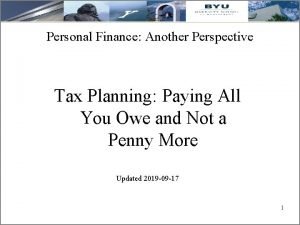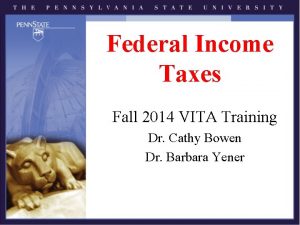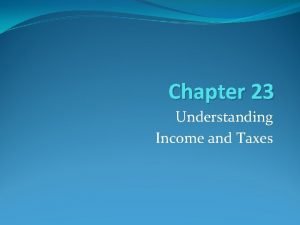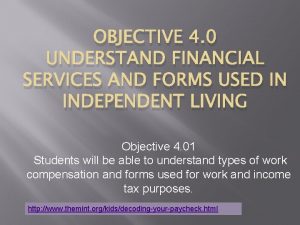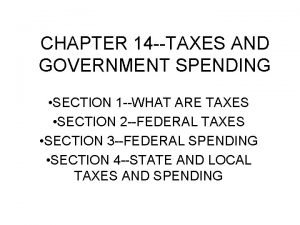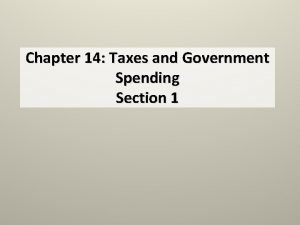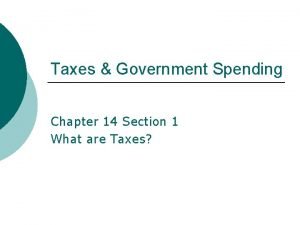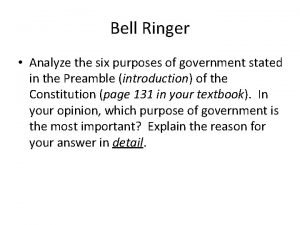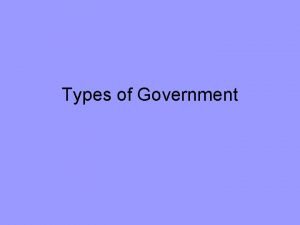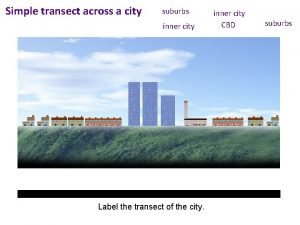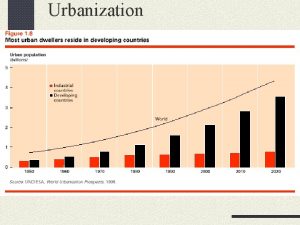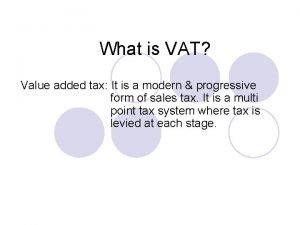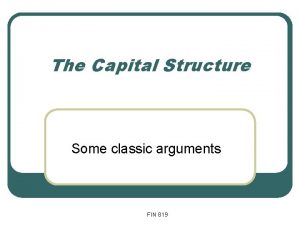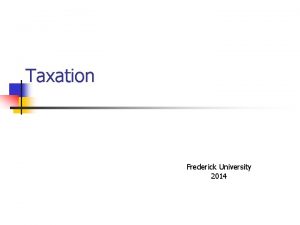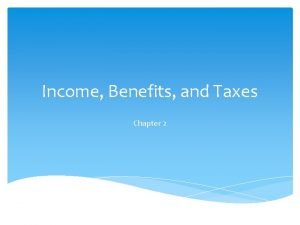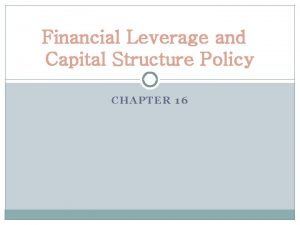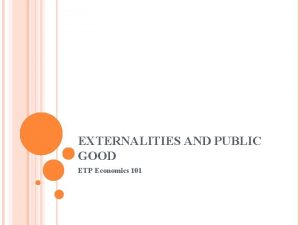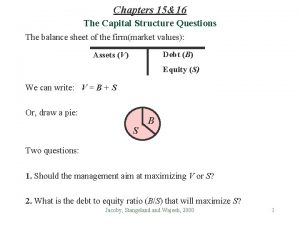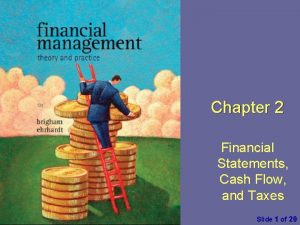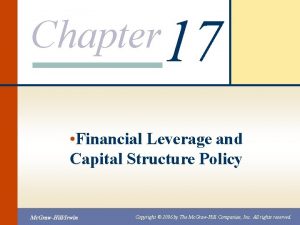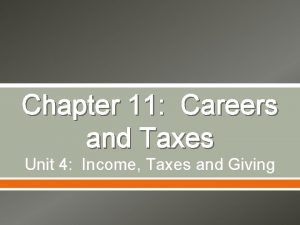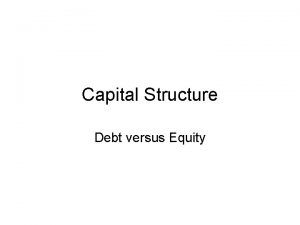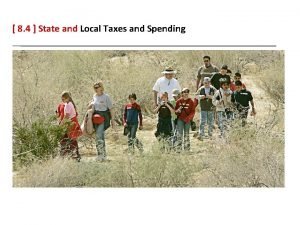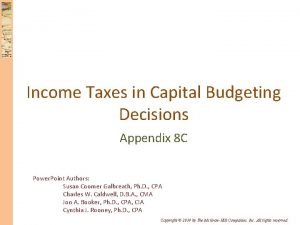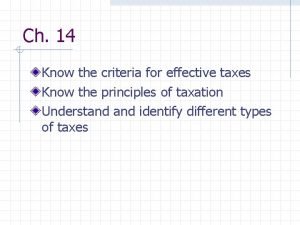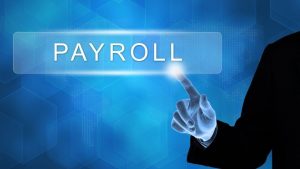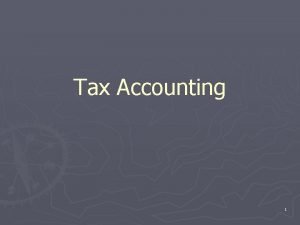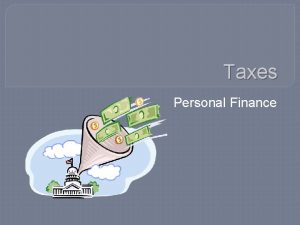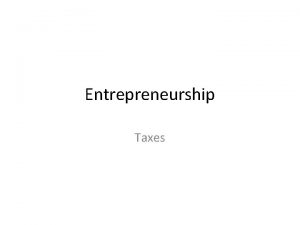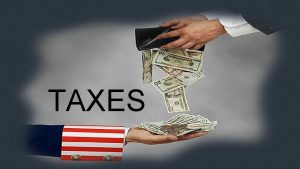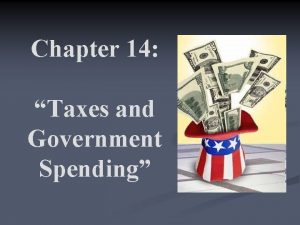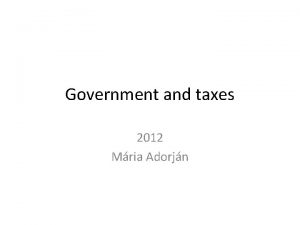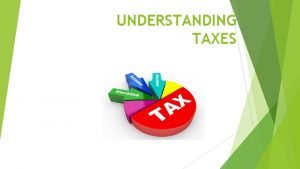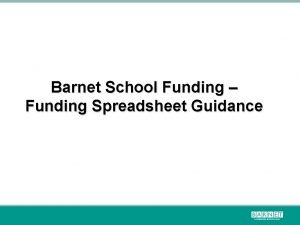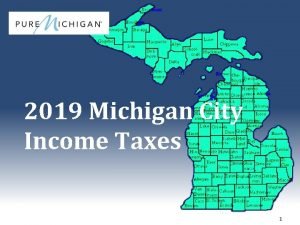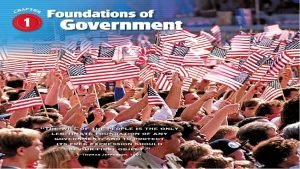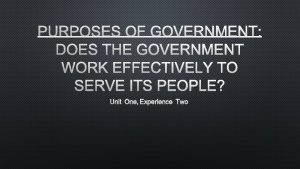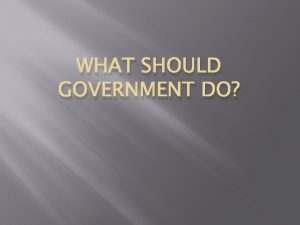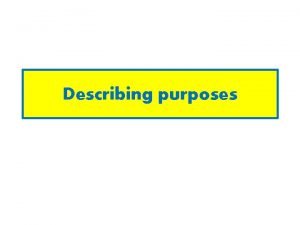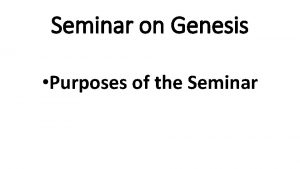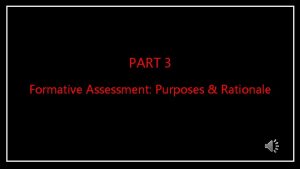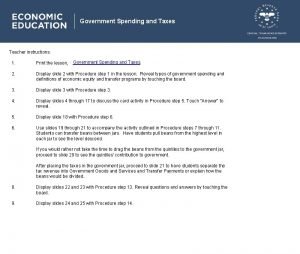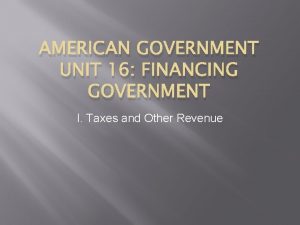Funding City Services Understanding Taxes Purposes for Government














































- Slides: 46

Funding City Services Understanding Taxes

Purposes for Government A primary reason to organize ourselves as cities is to foster a sense of community and belonging Most goals around which we form governments are to provide benefits that are difficult to achieve as individuals or through private businesses Who would build our roads, raise our armies, or provide our parks if we did not collectively do it? It is important to assure that government activities add to the greater public good and are balanced to serve major needs of all segments of society within our ability to pay

Municipal Services Municipalities rarely engage in some activities, such as welfare, education, and building highways, because they are the responsibility of other entities. Towns and cities provide many of the remaining services, including most of the services that directly affect our daily lives. Public Safety Police Fire Ambulance Water, sewer, trash Streets, sidewalks Parks and recreation Libraries, culture City planning Economic development

The Average Utah Household Pays About $600 in Municipal Taxes Annually

Taxes We HAVE to pay for government services, and we mostly do so through taxes We pay taxes whether or not we want/use the services they fund The degree to which we think government ought to provide more/fewer services is a primary reason for voter choices Cities can bond (borrow) to pay for infrastructure improvements, but must budget repayment, and must have a balanced budget

Taxes Only the federal government can spend more than it collects in taxes, creating debt that must be paid by future citizens The national debt is now about $11, 308, 127, 000 – each US citizen owes about $37, 000 This figure is up 10% in just the last 6 months, and is scheduled to rise by another 15 -20% with planned federal stimulus expenditures this year $11, 308, 127, 000

The Price of Local Government – Average for Utah Cities

Price of Local Government – Average for State Plus Cities

Price of Municipal Government – by State for the Western Region

Price of State Government – for the Western Region

Comparing Government Across Locals Be careful about making comparisons Circumstances differ across locals: The primary reason Utah has somewhat higher state taxes is a much larger than average birth rate. Aside from much higher than average costs for public education, Utah governmental costs are below average. In fact, our per-student expenditures are among the lowest in the nation. Differences also arise because of choices about adequacy, affordability, and competitiveness. Cities try to provide what their citizens want and are willing to pay for

Where Does Your Tax Dollar Go? Utah Averages

Common Tax Misconception The rich don’t pay much in taxes Fact: The top-earning 25% of taxpayers (AGI over $64, 702) earned 68. 2% of the nation's income, but paid 86. 3% of federal income tax. The top 1% of taxpayers (AGI over $388, 806) earned approximately 22. 1% of the nation's income, yet paid 39. 9% of federal income taxes. That means the top 1% of tax returns paid about the same amount of federal individual income taxes as the bottom 95% of tax returns. In contrast, the bottom 50% of all taxpayers averaged $450 tax person (many of these don’t pay any).

Common Utah Tax Misconceptions Fallacy: 24% of surveyed citizens believe cities receive income tax revenue Fact: Cities don’t collect income tax; in Utah all state income tax goes to public education Fallacy: 40% believe the state receives property tax revenue Fact: Depending upon the locale, about 55% of this tax goes to the local school district, 20% to the county, 15% to city

Your Tax Responsibility Typical adults pay about 25% - 40% of their income into taxes of all types, depending on their income Because income taxes are highly progressive, your burden for this type of tax depends on your income Lower income people pay very little (or no) Federal Income Tax This means that when candidates talk on and on about tax breaks for the poor, they aren’t saying much—In fact, sometimes what they really mean is wealth redistribution (tax the rich more to give to poor through government programs)

Average Tax Burden In 2008, average Americans worked 74 days to pay their federal taxes and 39 more days to pay state and local taxes. Careful about “average”—remember that lower income persons might pay off their entire federal income tax in 1 week of work or less This means that an average American taxpayer pays 31% of annual income for all forms of taxation Utah places about 20 th among the states for tax burden (due to lots of kids and costs of educating them—without the extra burden of education, the ranking would be much lower)

Most Common Forms of Taxation Federal and state income tax Usually regarded as most progressive (rich pay more) Ad valorem taxes (sales tax, tariffs, inheritance) Sales tax is usually regarded as most regressive (rich pay more because they buy more, but poor pay proportionally more of their income) Entitlements taxes (Social Security, Medicare) Property tax Corporate and excise taxes Often regarded as hidden taxes because the entities taxed pass on the cost to the consumer

Federal Income Tax It’s Actually Pretty Low Right Now* *In recent years, the rate is starting to rise back up

We Love to Complain About Taxes In fact, the federal tax for most people was recently at its lowest rate in decades, although creeping back up in the last few years

*A little over half of debt is for past defense spending Note: Remember that this is just income tax. The Federal budget includes other sources of income spent elsewhere, most notably Social Security and Medicare

Average Household Tax Burden For a Typical Household Income of $40, 000

Typical Tax Burden Based on family of five, income of $62, 677 Type of Tax % Fed. Social security $7155 45% $7155 $0 $0 1673 11 1673 0 0 Employment taxes 553 3. 5 553 0 0 Excise taxes 281 1. 8 281 0 0 Federal income taxes 230 1. 4 230 0 0 State income taxes 1831 11. 5 0 0 1831 0 0 Sales taxes 1805 11. 4 0 1301 0 224 280 Property taxes 1437 9. 1 0 0 799 431 216 913 5. 8 401 347 0 83 83 15878 100 10293 1648 2620 738 579 65% 10% 16% 5% 4% Medicare Auto taxes (gas) Total % of total tax State *For this family, taxes represent about 25% of total income Schl. Cnty City

The Federal Budget May Be in Trouble Whereas Federal tax rates are pretty stable, spending is growing rapidly Entitlement programs are unsustainable without major tax increases Huge debt will hamper our ability to solve our problems Fortunately, our state and local governments are in much better shape, mostly because of cost containment and avoidance of entitlements

2007 Federal Budget Expenditures & Revenues (deficit of $162 billion; will be in the trillions for 2009)

Social Security, Medicare, Medicaid as % of Federal Budget

Mandatory Spending is Consuming a Growing Share of the Federal Budget

Change in Composition of Discretionary Spending

An Aging Population American are living longer and having fewer children Thus, fewer workers are available to support each Social Security recipient

Health Care Costs are Rising Much Faster than the Economy

Economic Trends that Challenge Municipal Taxation Sources Our high birth rate and increasing longevity mean increased reliance on wage earners to support the young and old Our movement towards a service-based economy means a growing proportion of our economy is exempt from municipal taxation E-commerce generates no municipal taxation, and other technology reduces the need for real property (e. g. , factories)

Utah Tax Trends – Comparing across Two Years 1985 $2. 5 billion total State budget $714 million total municipal revenue (1990) 7. 7% of state budget dedicated to Medicaid $144 million state Medicaid expenditures Income tax burden: $25 per $1, 000 of personal income Property tax burden: $36 per $1, 000 of personal income Sales tax burden: $39 per $1, 000 of personal income 2005 $9 billion total State budget $1. 4 billion total municipal revenue (2004) 18% of state budget dedicated to Medicaid $1. 6 billion State Medicaid expenditures Income tax burden: $32 per $1, 000 of personal income Property tax burden: $25 per $1, 000 of personal income Sales tax burden: $35 per $1, 000 of personal income

Municipal Summary Although federal budgets face extreme challenges, municipal budgets have been relatively stable However, the status quo is threatened for municipalities because (a) they have limited control over their own ability to maintain current taxation levels and (b) other government entities have overcommitted or postponed meeting their needs In the last major tax overhaul (over 30 years ago), Utah developed a municipal tax structure where property taxes would mostly pay for all operating expenses and sales/use taxes would pay for capital improvements.

Five Principles of Sound Tax Policy 1. 2. 3. 4. 5. Simple – clear and easy to administer Fair – depends heavily on one’s perspective Efficient – generates adequate revenue with low administrative cost Stable – predictable revenue Transparent – open to citizens with rational ties to services provided

Surveys of Utah Citizens Fact: In Utah, property taxes are a major source of funding for counties, cities, and schools only.

Surveys of Utah Citizens

Utah’s Property Tax Burden

Understanding Property Tax The county places a valuation on real property (homes, business, land) The taxing entities (cities, counties, schools) set a tax rate The tax is calculated by multiplying the assessed value by the tax rate (reduced by 45% for homes) Lindon’s tax rate is currently. 001296 A home valued at $300, 000 would have city property tax of $214 In Lindon, about 13% of your property tax is for the city, 72% for the school district, and 15% for the county

Understanding Property Tax An increase in the assessed value of a home does not mean property tax goes up As assessed values go up, the tax rate goes down so that the same dollar amount of tax is assessed A taxing entity must hold a “Truth in Taxation” hearing to adjust the tax rate Because of inflation, the value of property taxes collected will steadily decline unless to taxing entity holds a hearing and raises the tax rate. Lindon has not increased the tax rate for as long as we have records, so homeowners now have a much lower tax rate than they did years ago

Understanding Property Tax As compared to other cities in Utah County, Lindon’s property tax rate is one of the lowest Over just the last 10 years, the contribution of property tax to Lindon’s revenue has declined from 38% in 1998 to just 18% in 2007 Over time, the most stable source of municipal revenue will decline unless the city acts Contrary to the intent of the state tax plan for municipalities, Lindon must now heavily subsidize its general operations from the sales tax

Lindon’s Property Tax Rate 1988 to 2008

Lindon Tax Revenues, 1998 v. 2008

Property Taxes Failing to Keep Up with Rising Population

Utah’s Sales Tax Burden Utah’s ranking is now higher due to recent reduction in our tax on food and tax increases in other states

Sales Tax in Lindon The sales tax in Lindon is 6. 75% 1% of this, goes to cities, 4. 7% goes to the state, . 25% goes to the county, and the rest goes to county transportation funds The 1% city portion is allocated in two ways: Half goes to the city where the tax was generated Half goes into a general fund that is distributed to all cities in the state based on population Because of this distribution formula, only about 60% of the municipal portion sales taxes generated in Lindon comes back to Lindon City

A Balanced Municipal Tax Portfolio The recent economic downturn exposes the folly of becoming too dependent on sales tax from a period of economic boom For the first quarter of 2009, Utah’s sales tax is down over 11%, 8 th worst in the nation Lindon’s sales tax decline is a bit worse than this state average Good tax policy includes a variety of revenue sources, including the stability of property taxes and the growth ability of sales taxes

Lindon City Budget For more information: Attend Lindon City budget hearings held each June, Request budget information from out City Treasurer, or Look for detailed budget information to appear on-line soon
 Understanding taxes
Understanding taxes Understanding taxes
Understanding taxes Chapter 23 understanding income and taxes
Chapter 23 understanding income and taxes Www.irs.gov/app/understanding taxes/student/simulations.jsp
Www.irs.gov/app/understanding taxes/student/simulations.jsp Chapter 14: taxes and government spending section 1
Chapter 14: taxes and government spending section 1 Government taxes definition
Government taxes definition Chapter 14 taxes and government spending
Chapter 14 taxes and government spending Chapter 14 taxes and government spending
Chapter 14 taxes and government spending Elmira city school district calendar
Elmira city school district calendar Circular city funding guide
Circular city funding guide Services seta funding
Services seta funding 6 purposes of government
6 purposes of government Lesson 1 purposes and origins of government
Lesson 1 purposes and origins of government The purposes of government
The purposes of government What are the three levels of government
What are the three levels of government Pros of latin american city model
Pros of latin american city model Cbd inner city suburbs
Cbd inner city suburbs Primate cities
Primate cities Value added tax
Value added tax Mm proposition ii with taxes
Mm proposition ii with taxes How much does wanda earn per hour
How much does wanda earn per hour How many types of taxes are there
How many types of taxes are there Examples of progressive tax
Examples of progressive tax Classification of taxation
Classification of taxation Chapter 2 income benefits and taxes
Chapter 2 income benefits and taxes Financial distress costs
Financial distress costs Mm proposition ii with taxes
Mm proposition ii with taxes Corrective tax
Corrective tax Mm proposition ii with taxes
Mm proposition ii with taxes 3 benefits of paying taxes
3 benefits of paying taxes Total net operating capital
Total net operating capital Homemade leverage problems
Homemade leverage problems Unit 4 chapter 11 careers and taxes answers
Unit 4 chapter 11 careers and taxes answers Advantages of debt
Advantages of debt Taxes in russia
Taxes in russia Calculate income tax
Calculate income tax State and local taxes and spending
State and local taxes and spending Tax sheild
Tax sheild Flow chapter 2
Flow chapter 2 3 criteria for effective taxes
3 criteria for effective taxes People often refer to taxes
People often refer to taxes Payroll tax journal entry
Payroll tax journal entry Classification of taxes
Classification of taxes Cash is current asset or not
Cash is current asset or not The colonists paid lower taxes on molasses because of the
The colonists paid lower taxes on molasses because of the Difference between fas 109 and asc 740
Difference between fas 109 and asc 740 Spinning jenny
Spinning jenny
